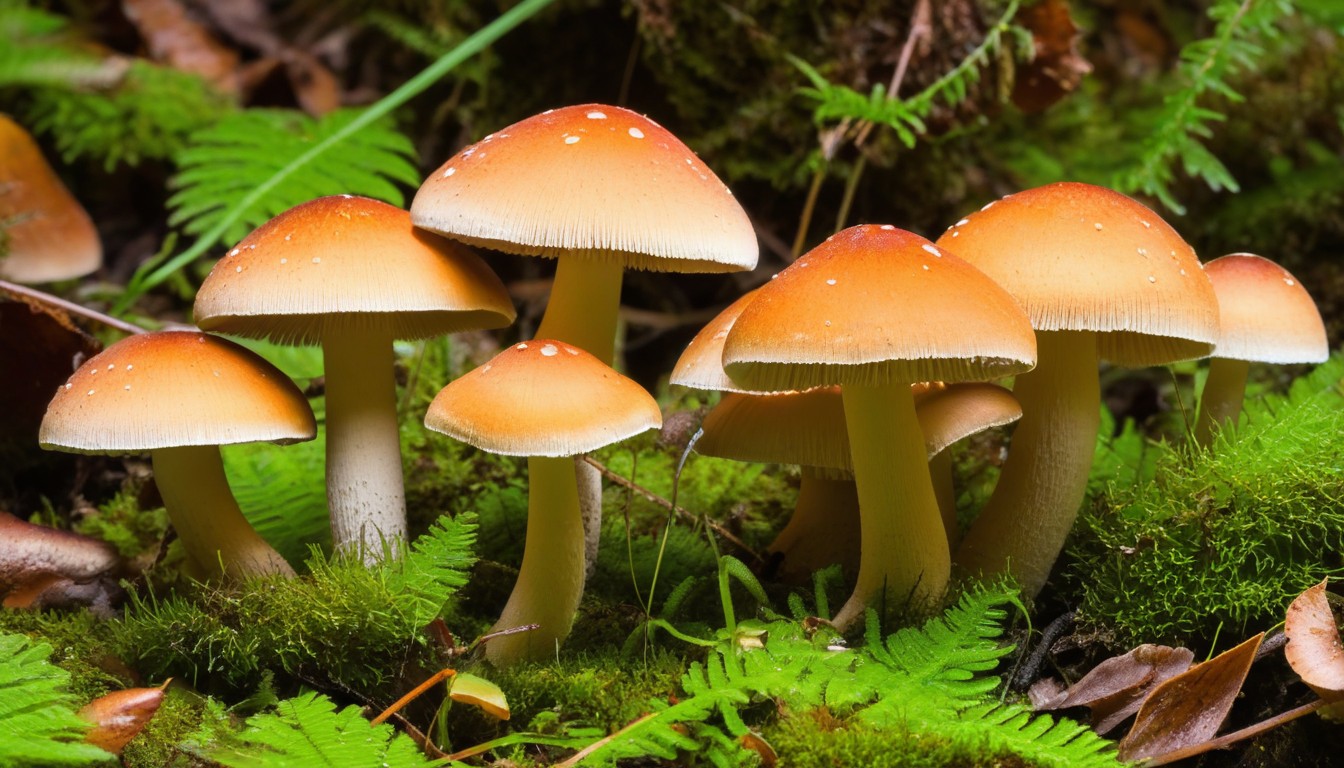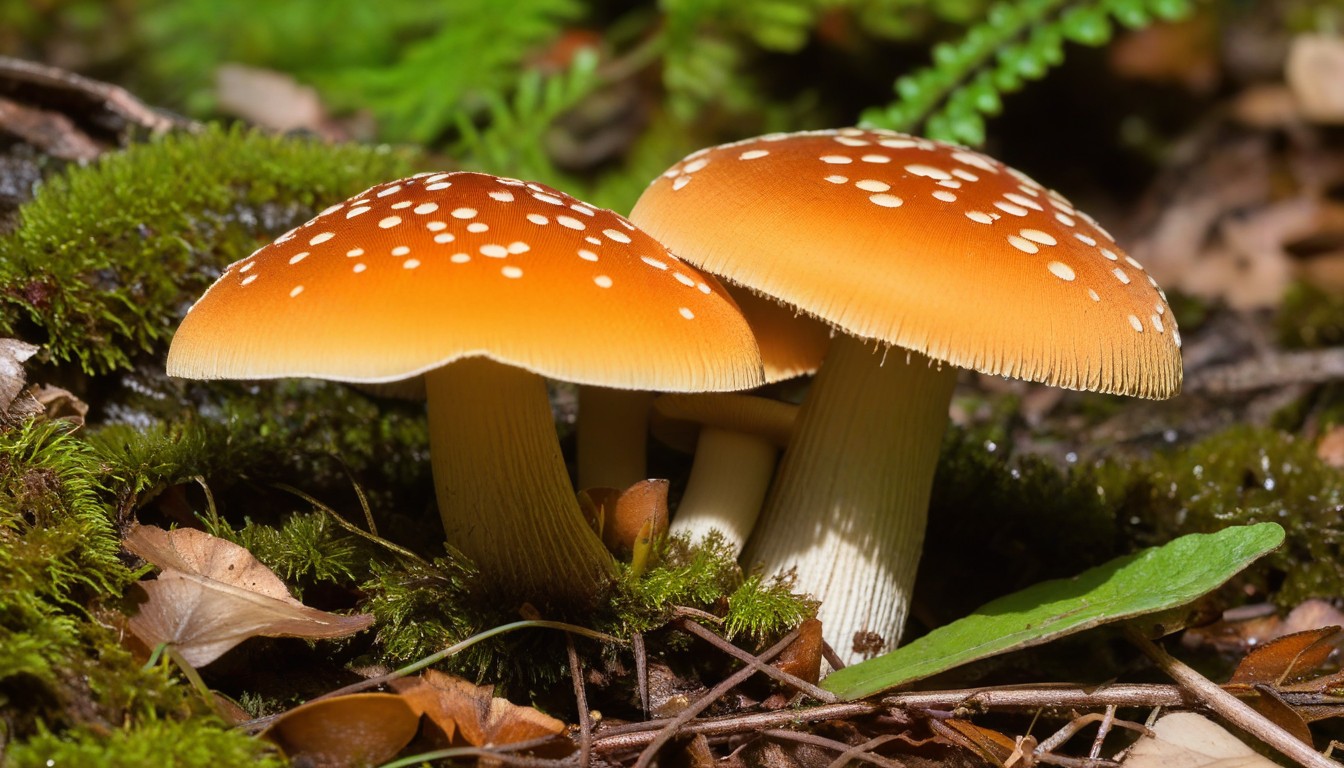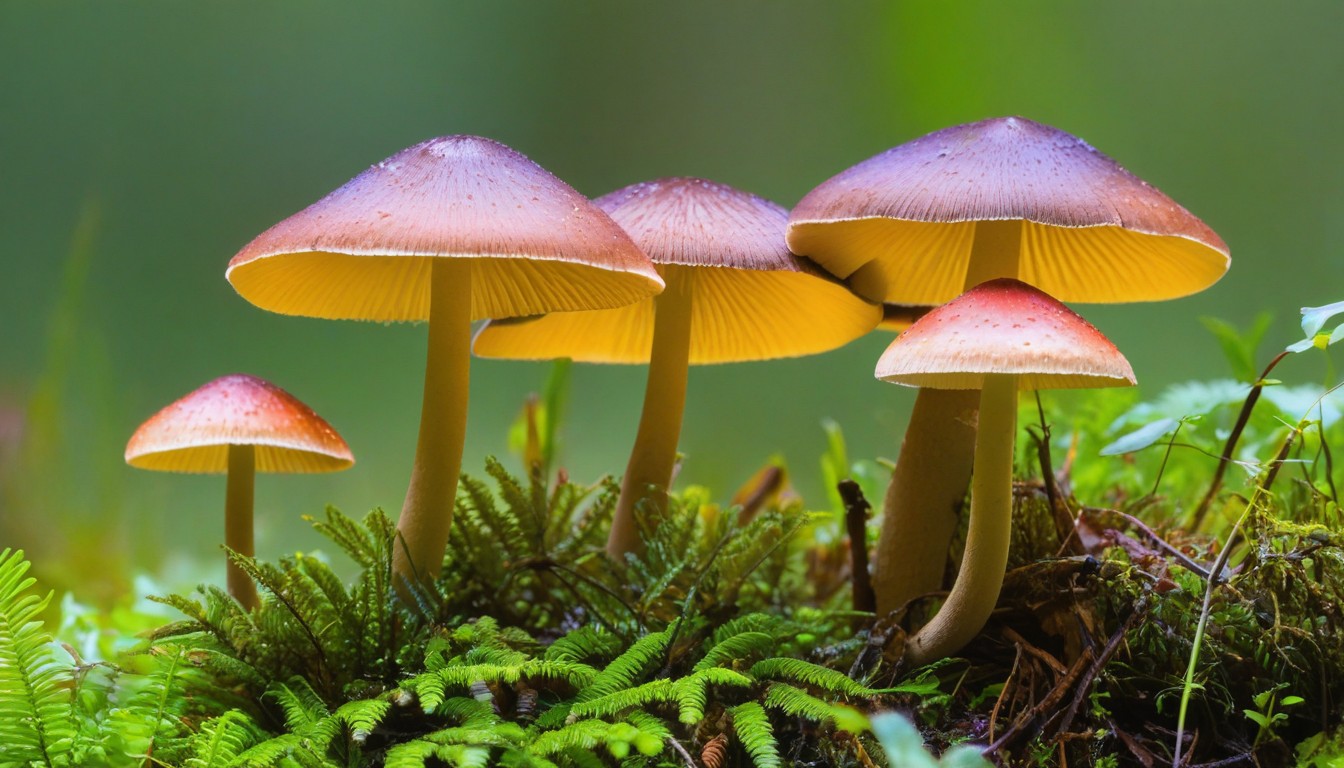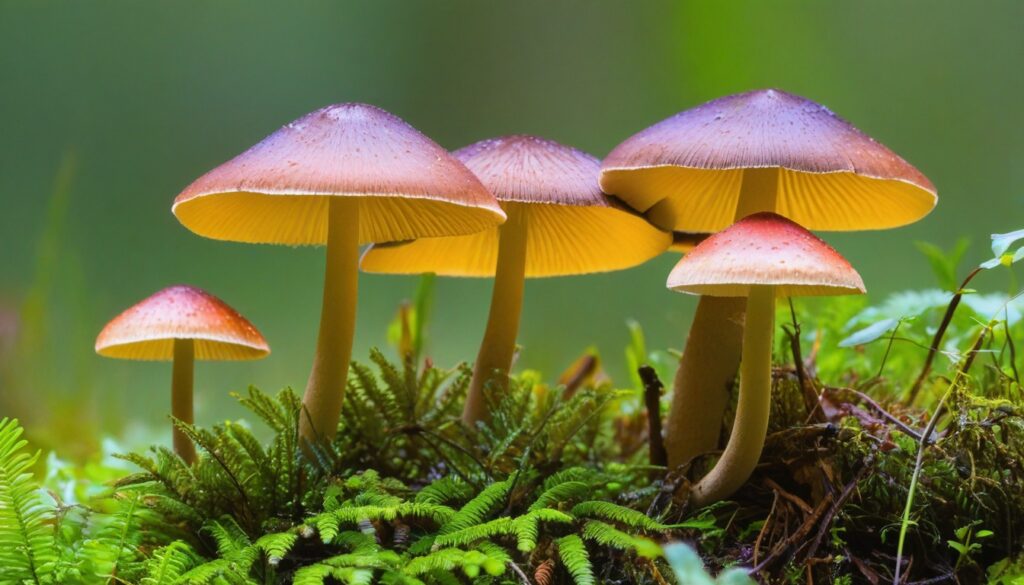Welcome to our comprehensive guide to Pluteaceae mushrooms! Whether you’re an avid mushroom hunter or just starting, this guide will provide you with essential tips and information for identifying and using mushrooms from the Pluteaceae family. From their various physical characteristics to their culinary and medicinal potential, these fascinating fungi have much to offer. In this guide, we’ll explore the basics of Pluteaceae mushrooms, provide tips for identifying them, and discuss their diverse uses.
Key Takeaways:
- Learn how to identify Pluteaceae mushrooms based on their physical characteristics.
- Discover the various culinary and medicinal uses of these fascinating fungi.
- Understand the importance of sustainable foraging practices for the conservation of Pluteaceae mushrooms.
What are Pluteaceae Mushrooms?
Pluteaceae mushrooms are a fascinating family of fungi known for their unique characteristics and wide range of ecological roles. These mushrooms belong to the order Agaricales and are typically found growing in forested habitats, although some species thrive in grasslands and other habitats.
Taxonomically, Pluteaceae mushrooms are characterized by their spore-bearing structures, which are known as basidia. These basidia are typically found on the underside of the mushroom cap and are responsible for producing spores, which are essential for reproduction.
One of the most striking features of Pluteaceae mushrooms is their cap shape, which can range from convex to umbonate, with a wide variety of colors and textures. The gills of these mushrooms are typically free or narrowly attached to the stem and are often white or pinkish in color, although some species have more colorful or distinct gill structures.
In addition to their unique morphology, Pluteaceae mushrooms are ecologically important, playing vital roles in nutrient cycling and ecosystem functioning. They are also of great interest to mycologists, who study their taxonomic relationships and use them as model organisms to understand fundamental biological processes.
Identifying Pluteaceae Mushrooms
Pluteaceae mushrooms are a diverse family of fungi with unique physical features that distinguish them from other mushrooms. To identify them correctly, it’s essential to pay close attention to these characteristics.
Cap shape: Pluteaceae mushrooms have caps that range from convex to flat, with some species having a knob or bump at the center. The caps may be smooth or covered in fine hairs or scales, and some have a gelatinous coating.
Gill attachment: The gills – the small, blade-like structures found under the mushroom cap – are either free or adnexed (narrowly attached to the stem), or adnate (broadly attached to the stem).
Spore color: To determine the spore color, gently tap the cap of the mushroom onto a piece of white paper or glass surface, and observe the resulting spore print. The color may range from white to gray to brown, depending on the species.
To aid in identification, mushroom keys – detailed guides that lead the user through a series of yes/no questions based on the mushroom’s physical features – can be a useful tool. Some popular keys for Pluteaceae mushrooms include the Agaricales of Temperate Europe and Mushrooms of the Pacific Northwest.
Habitat and Distribution of Pluteaceae Mushrooms
Pluteaceae mushrooms come in a variety of shapes, sizes, and colors and are found in numerous habitats worldwide. They can be found in both urban and rural environments and thrive in a variety of ecosystems, from forests to grasslands to wetlands where they can grow on wood substrates or in soil. Identifying the ideal habitat and microclimate in which different species grow is key to successful mushroom hunting or cultivating. Below is a summary table of the most popular Pluteaceae mushrooms and their preferred habitats and distribution.
|
Common Name |
Scientific Name |
Habitat |
Distribution |
|---|---|---|---|
|
Pluteus cervinus |
Pluteus cervinus |
Deciduous tree logs and stumps |
North America, Europe, Asia |
|
Pluteus petasatus |
Pluteus petasatus |
Deciduous wood chips and bark |
North America, Europe, Asia, Australia |
|
Pluteus salicinus |
Pluteus salicinus |
Willow trees and stumps |
Europe |
|
Pluteus thomsonii |
Pluteus thomsonii |
Coniferous tree logs and stumps |
North America |
|
Volvariella murinella |
Volvariella murinella |
Soil in meadows and pastures |
North America, Europe, Asia |
While this table provides a general overview of the habitat preferences and distribution patterns of Pluteaceae mushrooms, there may be variations or additional information worth considering when hunting or cultivating. Always research and verify the information for your specific location and mushroom species to ensure a successful and safe experience.
Edible Pluteaceae Mushrooms

While not as widely known as some other culinary fungi, there are several edible species within the Pluteaceae family that are worth exploring. These mushrooms have a delicate, nutty flavor and are a delicious addition to soups, stews, and salads.
One of the most popular edible Pluteaceae mushrooms is the shaggy ink cap (Coprinus comatus). This mushroom has a distinctive appearance, with a tall, shaggy cap and delicate white gills. Shaggy ink caps are commonly found in meadows and fields and can be sautéed or grilled, making them a delicious addition to any meal.
|
Culinary Uses | |
|---|---|
|
Shaggy Ink Cap (Coprinus comatus) |
Sautéed or grilled |
|
Velvet Foot (Flammulina velutipes) |
Soups, stir-fries, and stews |
|
Pluteus cervinus |
Grilled or in omelets |
Another delicious Pluteaceae mushroom is the velvet foot (Flammulina velutipes). This mushroom has a velvety brown cap and long, thin stem and is commonly used in soups, stir-fries, and stews.
Pluteus cervinus is another edible species within the Pluteaceae family. This mushroom has a convex, brown cap and can be grilled or used in omelets for a tasty meal.
When foraging for edible Pluteaceae mushrooms, it’s essential to correctly identify the species and avoid any toxic or poisonous varieties. Always consult a knowledgeable expert and follow safe foraging practices.
Medicinal Properties of Pluteaceae Mushrooms

Pluteaceae mushrooms are not only admired for their distinct taste, but also for their medicinal value. These mushrooms are known to possess various health benefits that have been recognized and utilized for centuries.
Research has suggested that certain species of Pluteaceae mushrooms contain bioactive compounds such as polysaccharides, which have been attributed to various potential therapeutic properties.
Immune Boosting Properties
Studies have shown that Pluteaceae mushrooms possess immune-boosting properties due to their beta-glucan and polysaccharide content, which activate immune cells and enhance their function, promoting an improved immune response.
Antioxidant Effects
Pluteaceae mushrooms have also been recognized for their potential antioxidant effects, which are credited to their flavonoid content. Antioxidants are essential for neutralizing free radicals that cause oxidative stress in the body, and help in protecting against damage from cellular processes, such as aging.
|
Medicinal Properties |
Benefits |
|---|---|
|
Immune Boosting Properties |
Activates immune cells, enhances immune response |
|
Antioxidant Effects |
Neutralizes free radicals, protects against cellular damage |
Incorporating Pluteaceae mushrooms into your diet may help in promoting wellness and a healthy immune system. However, it’s important to remember that Pluteaceae mushrooms should not be used as a replacement for medical therapy.
Toxic and Poisonous Pluteaceae Mushrooms
While many Pluteaceae mushrooms have culinary and medicinal uses, it’s crucial to be aware of the potentially toxic and poisonous species that exist within this family. Some mushrooms contain harmful toxins that can lead to illness or even death if ingested. Therefore, it’s essential to know how to distinguish these dangerous species from their edible counterparts.
|
Mushroom |
Toxicity |
Symptoms |
|---|---|---|
|
Pluteus salicinus |
Highly toxic |
Severe gastrointestinal symptoms such as vomiting, diarrhea, and abdominal pain |
|
Pluteus cervinus |
Potentially lethal |
Organ failure, convulsions, and coma |
To avoid any mishaps, a good rule of thumb is to avoid consuming any Pluteaceae mushrooms unless you are 100% certain of their identity. It’s also important to practice sustainable foraging habits and avoid overharvesting any mushroom species to preserve their natural habitat and ecosystem.
Pluteaceae Mushrooms in Folklore and Culture

For centuries, mushrooms have been sources of inspiration, symbolizing different things in various cultures. Pluteaceae mushrooms are not left out of this rich tradition. They have mystical, and at times symbolic meanings and roles in different cultures worldwide.
In ancient Egypt, mushrooms were rare, and only the Pharaoh and his royal family were allowed to eat them, believing that they were the food of the gods. In China, mushrooms, including the Pluteaceae family, are considered a symbol of prosperity and longevity. Similarly, in Japan, the Pluteaceae mushroom, known as the Kurotamamatake, is celebrated for its umami flavor and believed to help preserve youthfulness.
In some cultures, mushrooms have even been used for medicinal and spiritual purposes. In North America, the Native Americans used mushrooms for spiritual and healing properties, with the Pluteaceae mushroom believed to protect hunters and fishermen from bad weather conditions. In Europe, the Celts and Vikings connected mushrooms with magic and created rituals based on them, while the medieval alchemists believed that mushrooms held the key to immortality.
“Know thyself!” Plato once said, and the wise man should add to it, “and know the mushrooms!”
-John Cage, American composer, and mushroom enthusiast.
Pluteaceae Mushrooms in Scientific Research
Pluteaceae mushrooms have always been a topic of interest for scientists and researchers due to their unique characteristics and potential applications. These mushrooms belong to an economically significant group, with some species being edible and others being studied for medicinal properties. Recent scientific research has shown that Pluteaceae mushrooms have a wide range of essential nutrients, antioxidants, and immunomodulatory compounds. They have also been found to be a source of physiologically active polysaccharides and natural products that possess antiviral, anti-inflammatory, antibacterial and antitumor properties.
According to The Journal of Microbiology and Biotechnology, Pluteaceae mushrooms are studied for their potential to produce valuable metabolites, such as terpenoids, steroids, and alkaloids. The study highlights that these fungi can produce extensive, diverse, and complex metabolites that can have significant pharmaceutical applications.
The scientific research has also discovered that Pluteaceae mushrooms have the medicinal properties that can help improve the immune system and provide relief from inflammation. Studies show that the compounds found in these mushrooms can protect the liver from toxins, making them a vital part of medical treatments.
|
Research Area |
Scientific Contributions |
|---|---|
|
Mycobiology |
Studies have shown that Pluteaceae mushrooms play a critical role in mycology, assisting in the discovery of unique enzymes, metabolites, and biopolymers. |
|
Food Science and Nutrition |
Research shows that edible Pluteaceae mushrooms are rich sources of dietary fibers, proteins, and essential amino acids that can aid in digestion and overall health improvement. |
|
Horticulture and Agriculture |
Studies have shown that Pluteaceae mushrooms can be an important component of sustainable agriculture, providing an alternative protein source for livestock and poultry. |
The scientific research on Pluteaceae mushrooms highlights the benefits of these fascinating fungi for different areas of study. Their unique characteristics and potential applications make them an essential topic of research for scientists and researchers worldwide.
Cultivating Pluteaceae Mushrooms

If you love pluteaceae mushrooms and want to grow them at home, this section will provide you with essential tips and techniques for successful cultivation. Follow these steps to create optimal growing conditions:
- Start by selecting a suitable substrate. Pluteaceae mushrooms prefer nutrient-rich substrates like sawdust, straw or hardwood.
- Next, prepare the substrate by sterilizing it to kill off any unwanted bacteria or spores that could harm the mushrooms.
- Once sterilized, add spores or spawn to the substrate. Spawn is the vegetative growth of mycelium, which is essential for mushroom cultivation. Pluteaceae mushrooms can be grown using liquid cultures or spore prints.
- Place the substrate in a warm, humid environment with plenty of airflow. The ideal temperature for pluteaceae mushroom growth is 75°F – 85°F.
- Maintain proper moisture levels by misting the substrate with clean water every 1-2 days.
- Harvest the mushrooms once they reach maturity, which typically takes 2-3 weeks after the initial growth stage.
By following these tips and techniques for mushroom cultivation, you can enjoy growing your own pluteaceae mushrooms at home. Experiment with different substrates and growing conditions to find what works best for you!
Conservation and Protection of Pluteaceae Mushrooms
Despite their ecological and economic importance, Pluteaceae mushrooms are facing several threats as a result of habitat loss and overharvesting. As responsible enthusiasts and foragers, it is our responsibility to protect and conserve these fascinating fungi for future generations to enjoy.
One way to contribute to the conservation of Pluteaceae mushrooms is to practice sustainable foraging and harvesting techniques. This includes avoiding over-harvesting, only picking mature specimens, and avoiding damage to their habitat. It’s also essential to respect local regulations and obtain any necessary permits before foraging.
Another way to support the conservation of Pluteaceae mushrooms is to contribute to mycological conservation efforts. Many organizations and programs exist to protect these fungi and their habitats, including the North American Mycological Association and the International Society for Fungal Conservation. Consider joining or donating to these organizations to help make a positive impact.
Threats to Pluteaceae Mushrooms
|
Threats |
Description |
|---|---|
|
Habitat Loss |
Pluteaceae mushrooms are highly dependent on specific ecological niches and are vulnerable to habitat degradation and destruction due to human activities such as logging, urbanization, and agriculture. |
|
Overharvesting |
Pluteaceae mushrooms are often targeted by foragers due to their culinary and medicinal potential. However, overharvesting can lead to population declines, which affects the ecosystem and threatens their survival. |
|
Climate Change |
The impacts of climate change, such as increased temperatures and altered precipitation patterns, can affect the distribution, phenology, and mortality of Pluteaceae mushrooms. |
|
Invasive Species |
The introduction of non-native species can displace native Pluteaceae fungi and alter their habitat and entire ecosystem. |
By taking a proactive approach, we can help ensure that Pluteaceae mushrooms continue to thrive in their natural habitats for years to come, while also enjoying their culinary and medicinal benefits with peace of mind.
Conclusion
In conclusion, this comprehensive Pluteaceae mushrooms guide has provided essential tips and techniques for identifying and exploring the uses of these fascinating fungi. By understanding their physical characteristics and preferred habitats, you’ll be better equipped to forage and cultivate these mushrooms successfully.
From their potential culinary uses, as seen in the edible varieties, to their medicinal properties, such as immune-boosting and antitumor effects, Pluteaceae mushrooms have much to offer. Further research and mycological conservation efforts are necessary to protect these mushrooms and their habitats.
With the information provided in this guide, we hope you will gain a greater appreciation for the diverse world of Pluteaceae mushrooms and enjoy exploring their unique characteristics, uses, and potential benefits.
FAQ
What are Pluteaceae mushrooms?
Pluteaceae mushrooms are a type of fungi belonging to the Pluteaceae family. They are known for their unique characteristics and diverse species.
How can I identify Pluteaceae mushrooms?
Pluteaceae mushrooms can be identified by examining their physical features, such as cap shape, gill attachment, and spore color. Detailed identification keys can also assist in recognizing these mushrooms in the wild.
Where can I find Pluteaceae mushrooms?
Pluteaceae mushrooms prefer specific habitats, including damp woods, grassy areas, and decaying organic matter. They can be found in various regions around the world.
Are there any edible Pluteaceae mushrooms?
Yes, there are edible species within the Pluteaceae family. However, it’s important to properly identify them and exercise caution when consuming wild mushrooms.
Do Pluteaceae mushrooms have medicinal properties?
Pluteaceae mushrooms have been used medicinally for centuries and are known to possess various health benefits. They are believed to have immune-boosting and antioxidant effects.
Are there any toxic or poisonous Pluteaceae mushrooms?
Yes, there are toxic and poisonous species within the Pluteaceae family. It is crucial to be knowledgeable about these varieties and be able to differentiate them from the edible species.
What is the cultural significance of Pluteaceae mushrooms?
Pluteaceae mushrooms, like many other fungi, have played a significant role in folklore and cultural practices. They hold symbolic meanings in different cultures and have been associated with mystical beliefs.
What scientific research has been conducted on Pluteaceae mushrooms?
Pluteaceae mushrooms have attracted the attention of scientists and researchers due to their unique characteristics. They have been studied for their taxonomy, ecology, and potential applications in various fields of study.
Can I cultivate Pluteaceae mushrooms at home?
Yes, it is possible to cultivate Pluteaceae mushrooms at home. This section will provide you with essential tips and techniques for successful mushroom cultivation, including optimal growing conditions and substrate choices.
How can I contribute to the conservation and protection of Pluteaceae mushrooms?
It is important to practice sustainable foraging and cultivation practices to protect Pluteaceae mushrooms and their habitats. Contributing to mycological conservation efforts can also help preserve these fascinating fungi.

